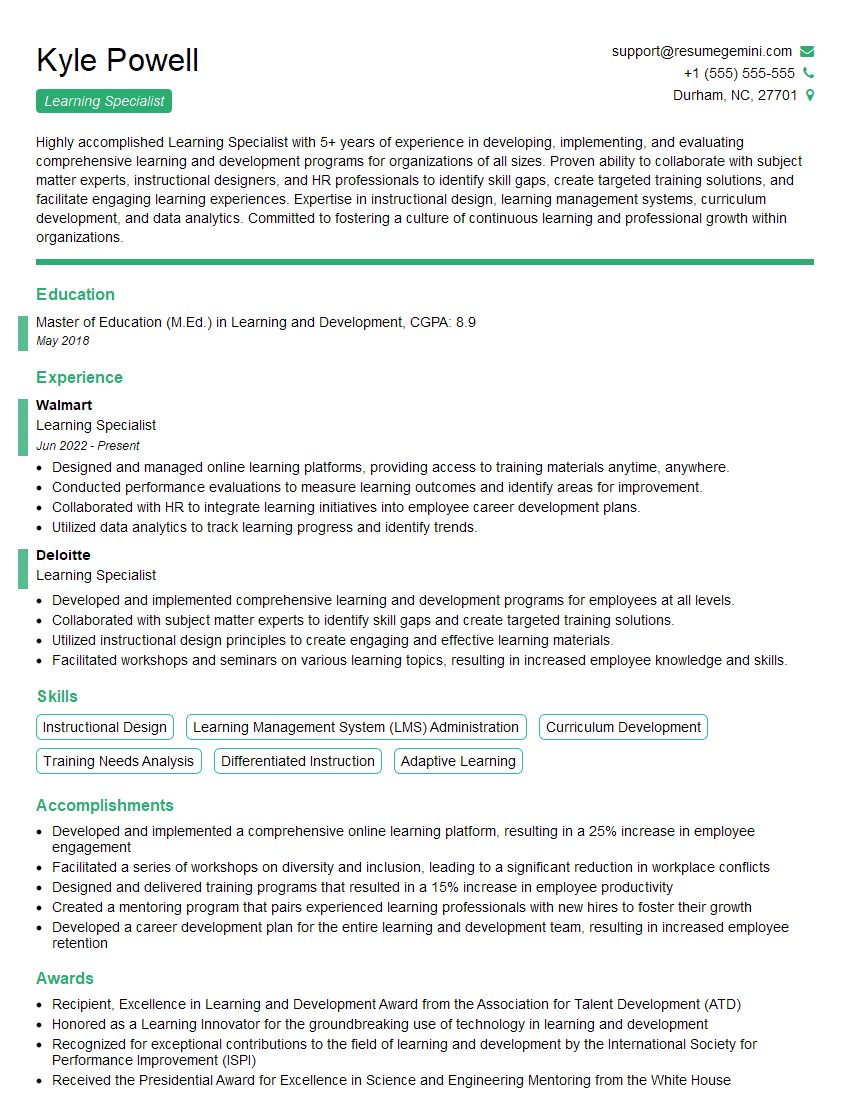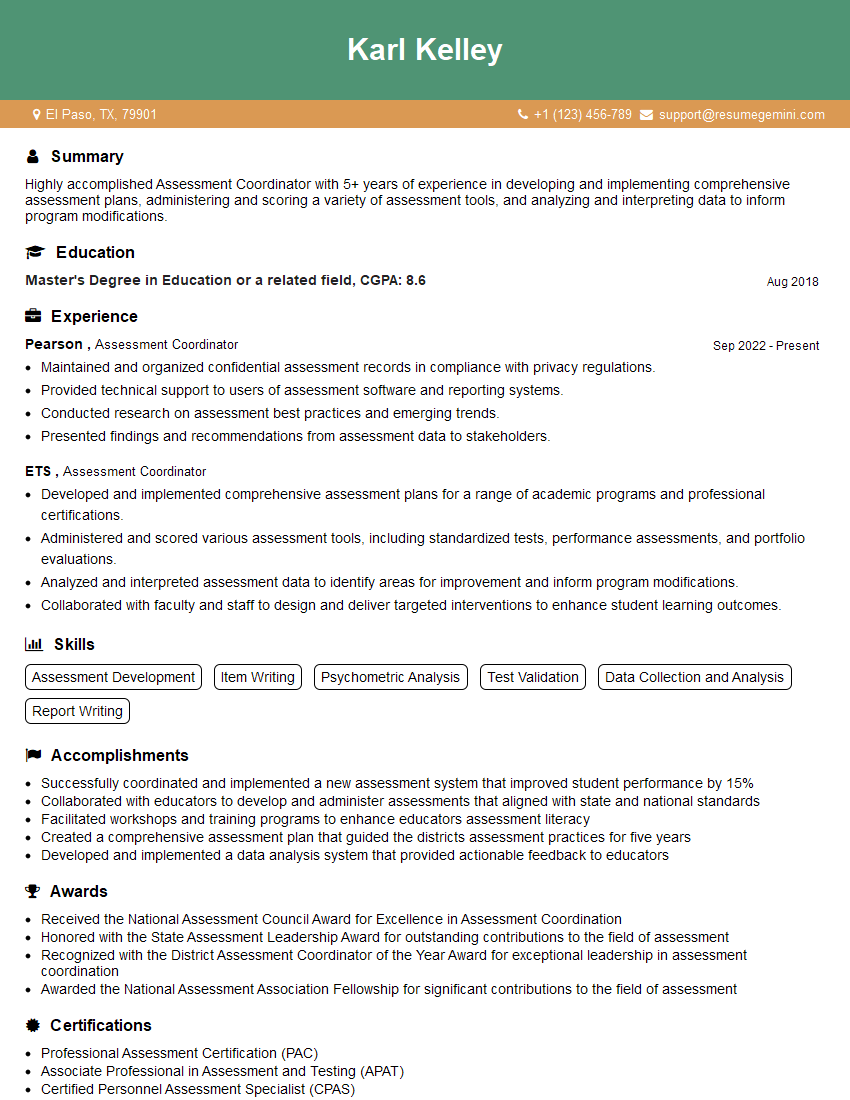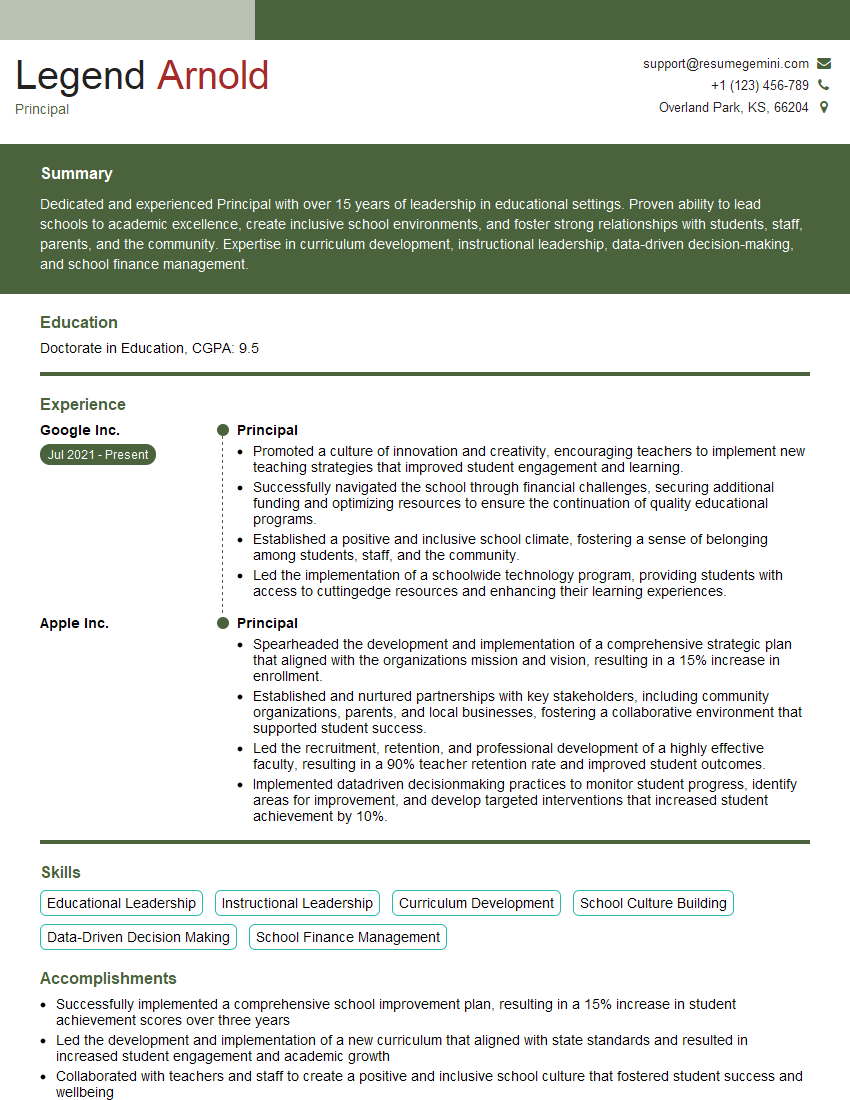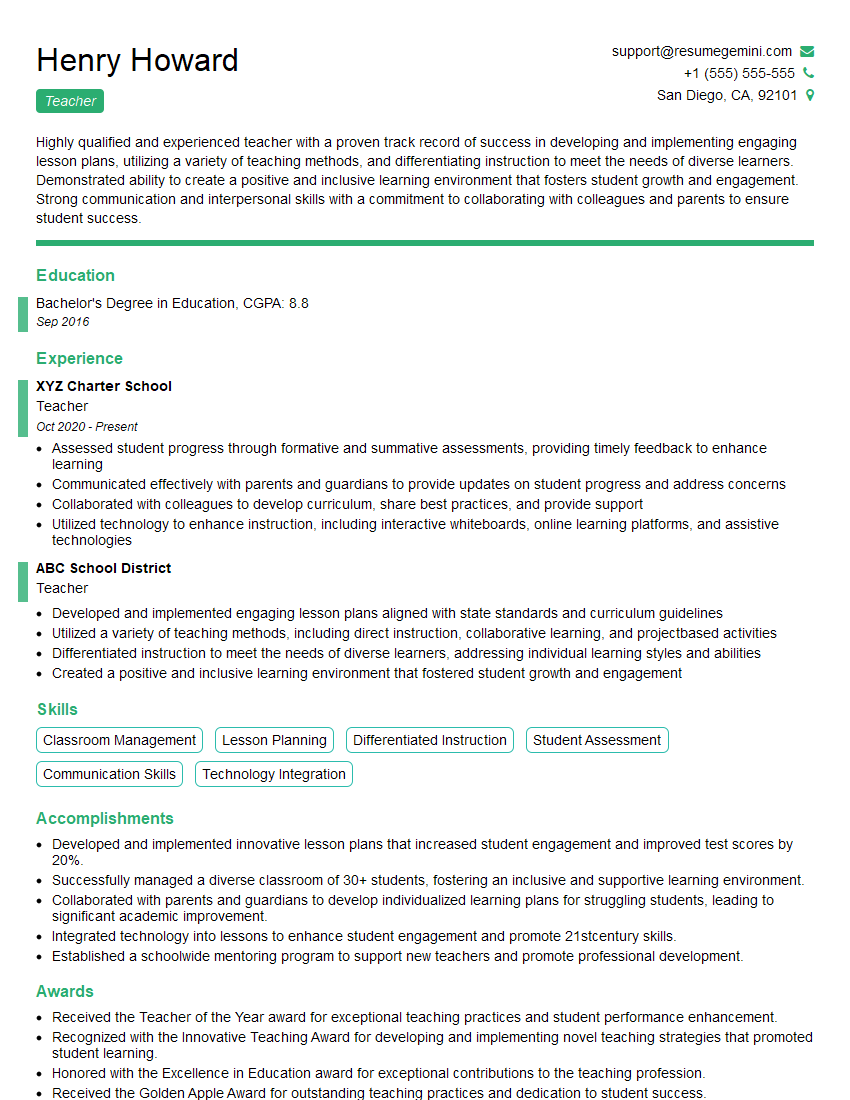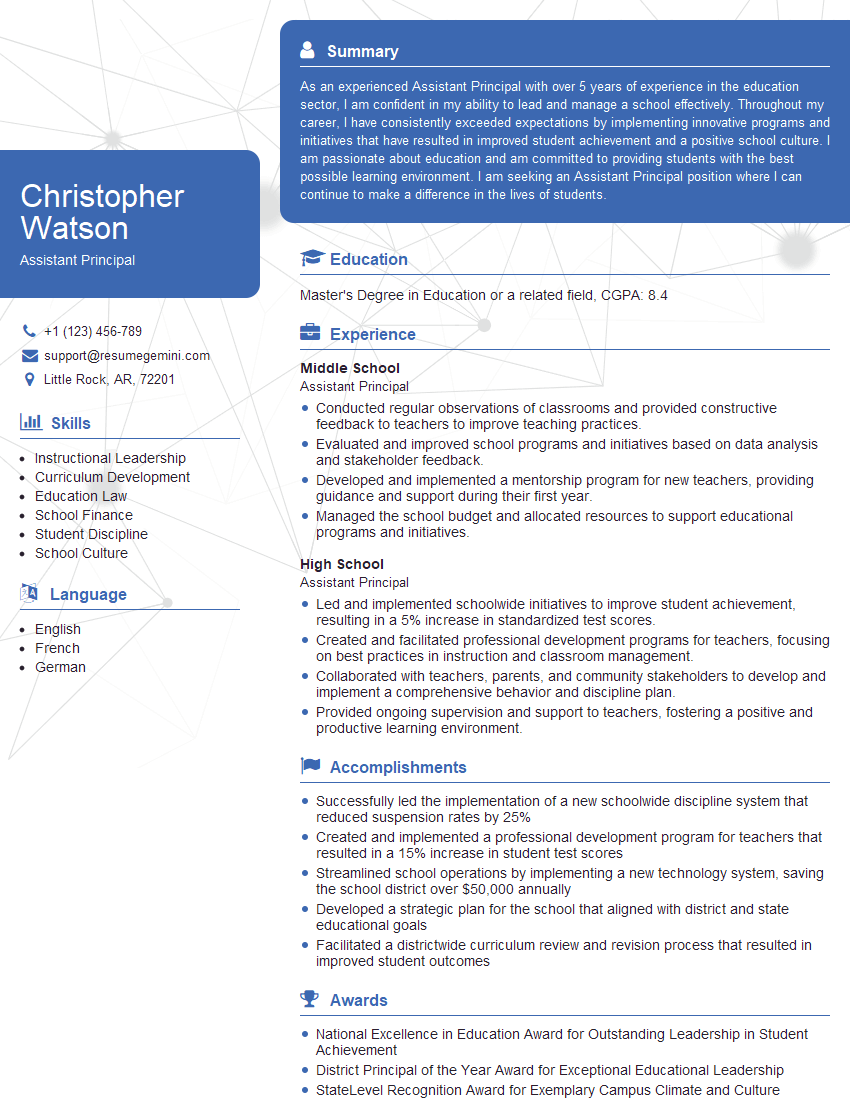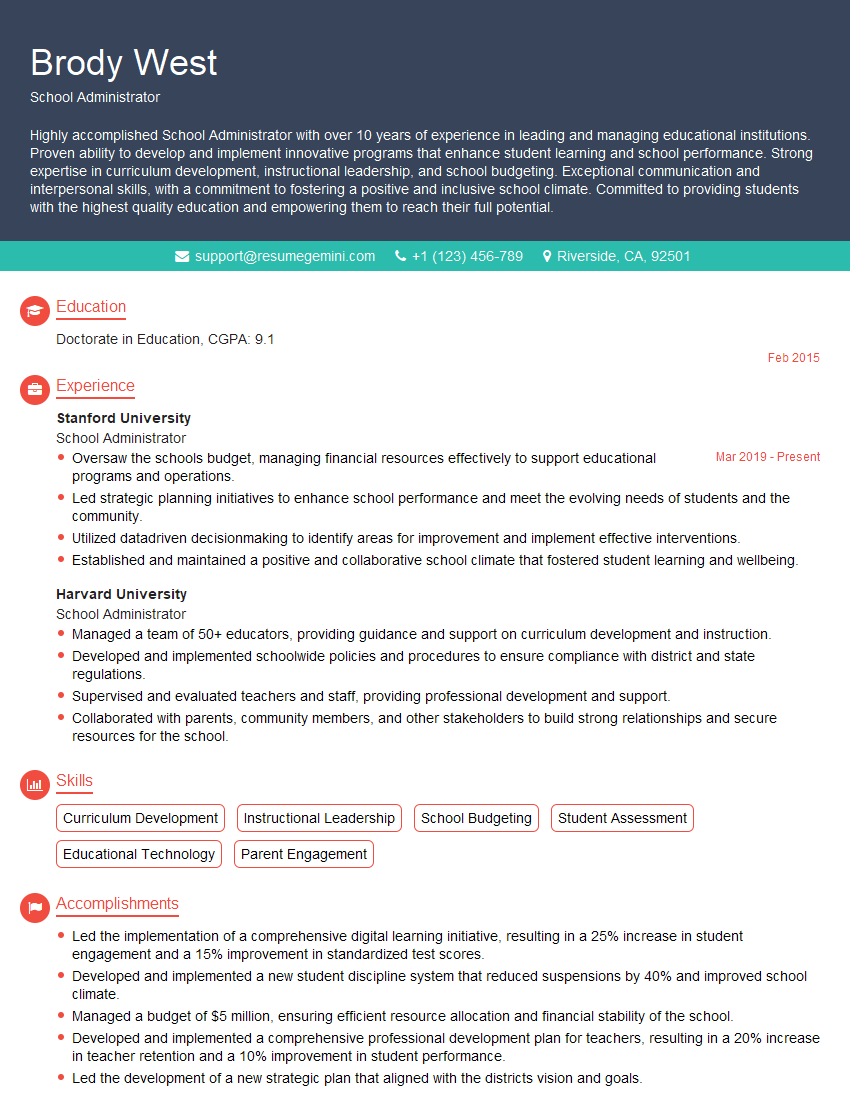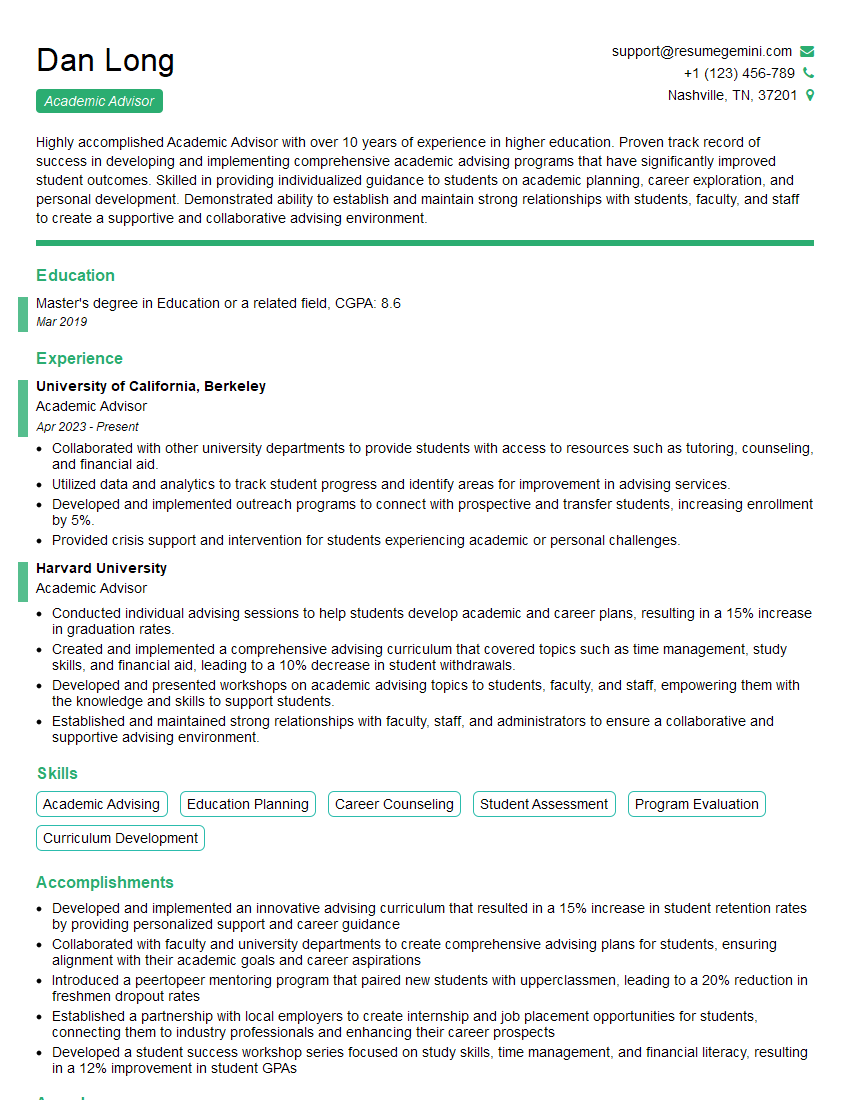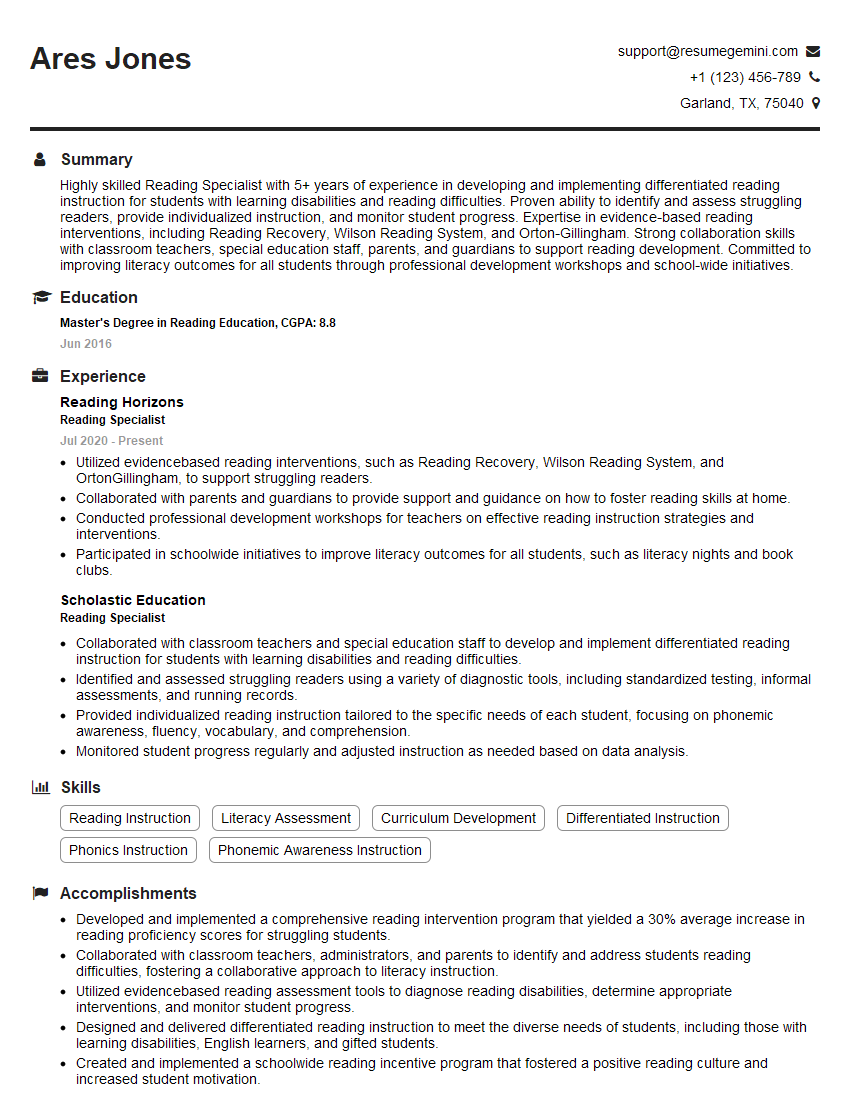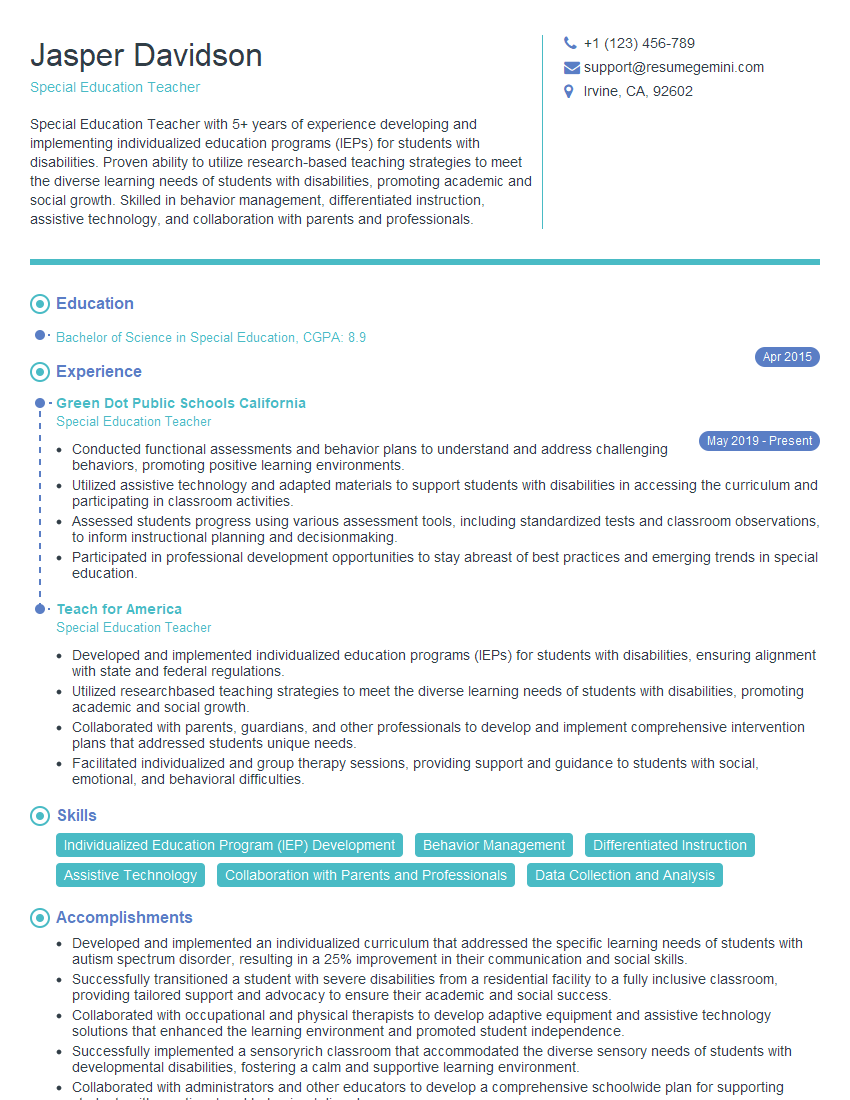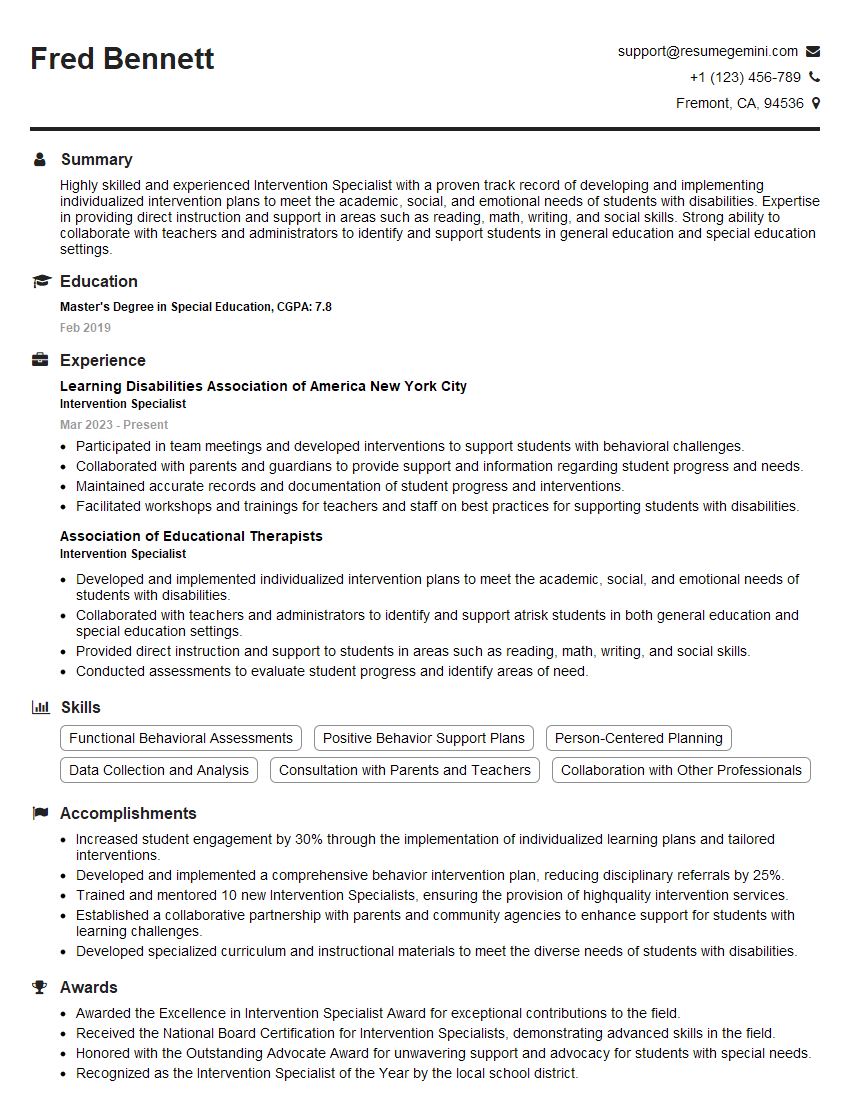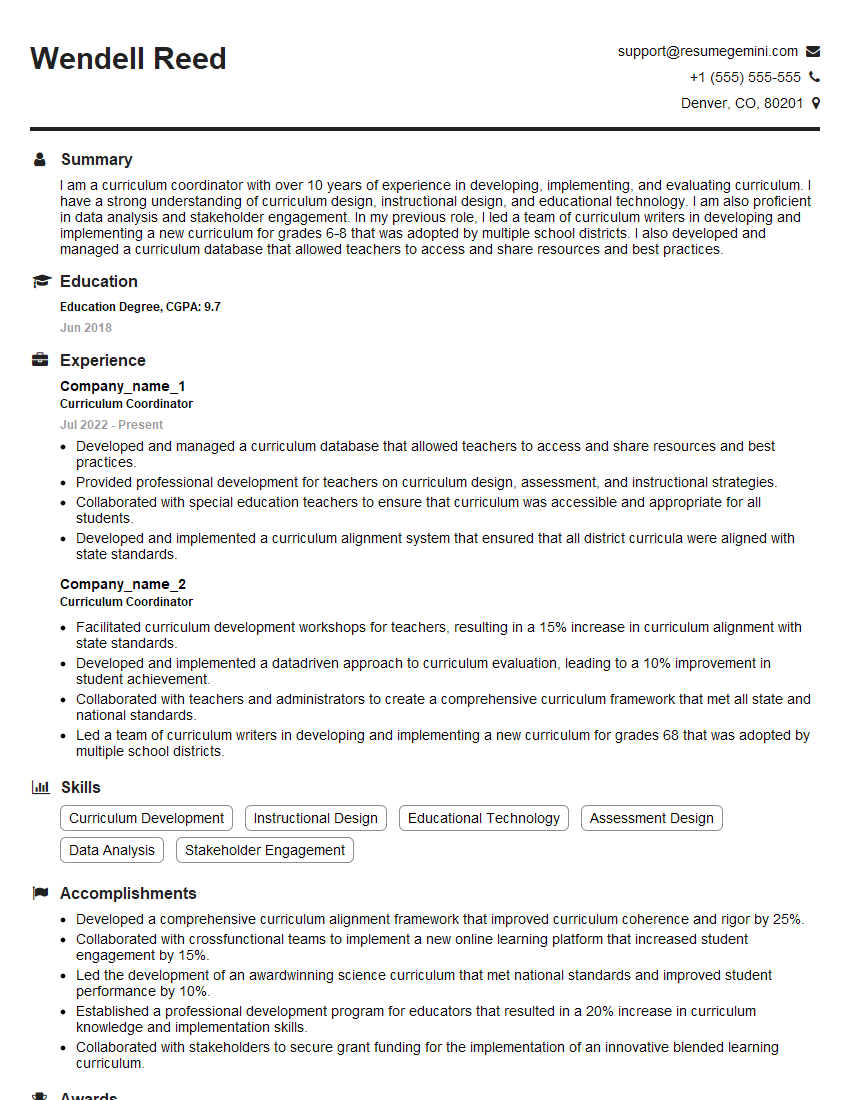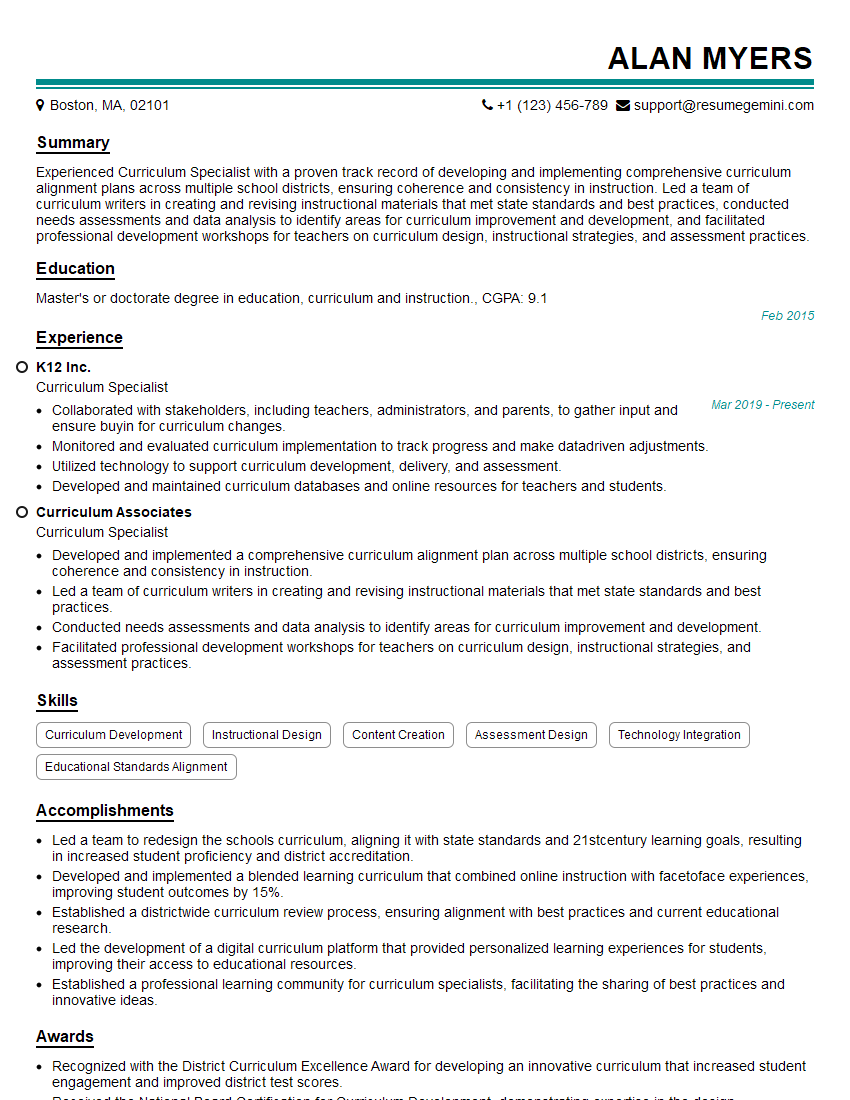The right preparation can turn an interview into an opportunity to showcase your expertise. This guide to StudentCentered Learning and Differentiated Instruction interview questions is your ultimate resource, providing key insights and tips to help you ace your responses and stand out as a top candidate.
Questions Asked in StudentCentered Learning and Differentiated Instruction Interview
Q 1. Explain the core principles of student-centered learning.
Student-centered learning flips the traditional classroom model, shifting the focus from the teacher as the sole source of knowledge to the student as the active learner. It’s built on the belief that students learn best when they’re engaged, motivated, and actively involved in the learning process.
- Active Learning: Students aren’t passive recipients of information; they actively participate through discussions, projects, problem-solving, and inquiry-based activities.
- Learner Agency: Students have a voice in their learning, choosing topics, methods, and even assessment formats within reasonable parameters.
- Collaboration and Communication: Learning is a social activity, encouraging teamwork, peer learning, and communication skills.
- Reflection and Metacognition: Students are encouraged to reflect on their learning process, identify strengths and weaknesses, and develop strategies for improvement. This involves thinking about their thinking (metacognition).
- Relevance and Authenticity: Learning is connected to real-world applications, making it meaningful and relevant to students’ lives.
Think of it like this: instead of a teacher lecturing for an hour, imagine a lively debate fueled by student-led research, followed by collaborative project work that culminates in a presentation showcasing their understanding. That’s the spirit of student-centered learning.
Q 2. How do you differentiate instruction to meet diverse learner needs?
Differentiating instruction is about tailoring teaching methods, materials, and assessment to meet the diverse needs of all learners in a classroom. This acknowledges that students learn at different paces, have varying learning styles, and possess unique strengths and weaknesses.
- Content Differentiation: Modifying the complexity or content of the material. For example, providing tiered assignments where students choose a level of challenge that aligns with their abilities.
- Process Differentiation: Changing how students access and process information. This might involve offering varied activities like group work, individual projects, or independent study.
- Product Differentiation: Allowing students to demonstrate their understanding in various ways. Some might prefer writing essays, others creating presentations, while some may thrive on hands-on projects.
- Learning Environment Differentiation: Adjusting the classroom environment to cater to diverse learning preferences. This could include providing quiet spaces for focused work or collaborative areas for group activities.
For example, in a lesson on fractions, I might provide simpler fraction problems for students who need more support, while challenging more advanced students with word problems requiring problem-solving skills. I’d also offer different ways to demonstrate understanding – a worksheet, a game, or a presentation.
Q 3. Describe a specific lesson plan you’ve created that exemplifies student-centered learning.
In a 7th-grade science class on ecosystems, I designed a project-based learning activity centered around creating a miniature ecosystem in a terrarium.
- Student Choice: Students chose the type of ecosystem (desert, rainforest, etc.) they wanted to replicate.
- Research and Collaboration: They researched the plants and animals native to their chosen ecosystem and collaborated in groups to design and build their terrariums.
- Presentation and Reflection: Each group presented their terrarium, explaining their design choices and the ecological principles involved. They then individually reflected on the process, challenges faced, and what they learned.
- Assessment: Assessment involved a rubric evaluating the scientific accuracy of their terrarium, the quality of their research and presentation, and the depth of their individual reflection.
This lesson incorporated active learning, student agency, collaboration, and reflection – all core elements of student-centered learning. The hands-on nature and student choice increased engagement and fostered a deeper understanding of complex ecological concepts.
Q 4. How do you assess student learning in a student-centered classroom?
Assessment in a student-centered classroom is less about high-stakes testing and more about ongoing, formative assessment that informs instruction and tracks student progress.
- Formative Assessment: This happens throughout the learning process using methods like observation, questioning, exit tickets, and informal quizzes to gauge understanding and adjust teaching strategies.
- Summative Assessment: This measures overall learning at the end of a unit, project, or course. It can include projects, presentations, essays, or tests, but should ideally align with the learning objectives and provide opportunities for student choice in demonstration.
- Self and Peer Assessment: Students actively participate in evaluating their own work and that of their peers, developing self-awareness and critical thinking skills.
- Performance-Based Assessment: Emphasis on demonstrating understanding through application, rather than simply recalling facts.
For instance, in the terrarium project, formative assessment involved observing student progress, providing feedback during the construction phase, and asking clarifying questions. Summative assessment included the final presentation and a self-reflection on the learning process.
Q 5. What strategies do you employ to foster student collaboration and engagement?
Fostering collaboration and engagement requires careful planning and implementation of strategies that make learning a social and interactive experience.
- Think-Pair-Share: Students think individually, discuss with a partner, then share with the whole class.
- Group Projects and Activities: Designing projects that require teamwork and collaboration to achieve a common goal.
- Jigsaw Activities: Students become experts on different parts of a topic and then teach each other.
- Classroom Discussions and Debates: Encouraging student-led discussions and debates to facilitate critical thinking and communication skills.
- Use of Technology: Incorporating interactive simulations, online collaboration tools, and educational games to enhance engagement.
The key is to create a supportive and inclusive classroom culture where students feel comfortable sharing ideas, asking questions, and working together. Establishing clear expectations for group work and providing opportunities for feedback are crucial.
Q 6. How do you address the needs of students with varying learning styles?
Addressing diverse learning styles is a critical aspect of differentiated instruction. Recognizing that students process information differently is essential for creating an inclusive learning environment.
- Visual Learners: Use diagrams, charts, graphs, videos, and visual aids.
- Auditory Learners: Incorporate discussions, lectures, audio recordings, and oral presentations.
- Kinesthetic Learners: Provide hands-on activities, experiments, role-playing, and movement-based learning.
- Reading/Writing Learners: Utilize readings, writing assignments, note-taking, and journaling.
It’s important to note that many students are a blend of learning styles. Offering a variety of learning experiences caters to these diverse preferences and maximizes learning opportunities for all.
Q 7. Explain your approach to providing differentiated feedback to students.
Differentiated feedback is tailored to the individual student’s needs and learning goals. It moves beyond simply grading and focuses on providing specific, actionable suggestions for improvement.
- Specific and Actionable: Feedback should be clear, concise, and focused on specific areas for improvement, offering concrete steps for improvement.
- Descriptive and Encouraging: Focus on what the student did well and areas for growth, using positive and constructive language.
- Targeted to Learning Goals: Align feedback directly with the learning objectives of the assignment or activity.
- Multiple Modalities: Offer feedback in various formats – written comments, verbal feedback, or even audio/video recordings.
- Student Involvement: Involve students in the feedback process by encouraging self-reflection and peer feedback.
Instead of simply writing “needs improvement,” I might say, “Your analysis of the data was strong, but consider adding a visual representation of the results to enhance understanding. Here’s a link to a tutorial on creating effective graphs.” This kind of specific feedback is much more useful for student growth.
Q 8. How do you use formative assessment to inform your instruction?
Formative assessment is the ongoing process of gathering information about student learning during instruction, not just at the end. It’s like taking the temperature of the classroom to see if everyone is understanding the material. I use a variety of methods to inform my instruction, focusing on getting quick, actionable feedback.
- Exit Tickets: Students answer one or two quick questions at the end of a lesson to show what they’ve grasped. If many students miss a key concept, I know to revisit it the next day.
- Think-Pair-Share: Students discuss a concept with a partner before sharing with the class. This allows me to observe understanding and identify misconceptions quickly.
- Quick Quizzes (low-stakes): Short, informal quizzes assess comprehension. These aren’t for grades, but for understanding where students are struggling.
- Observation: I actively watch students during group work or independent practice, noting their engagement and understanding. A student struggling silently might need individual support.
- Informal questioning: I regularly ask open-ended questions to gauge understanding, prompting deeper thinking and revealing misconceptions.
The data from these assessments helps me adjust my teaching strategies, re-explain complex topics, provide targeted support to individual students, or even change the pace of the lesson. It’s a dynamic process, constantly adapting to the students’ needs.
Q 9. Describe your experience with adapting curriculum to meet individual student needs.
Adapting curriculum is fundamental to differentiated instruction. It means recognizing that students learn at different paces and in different ways. My approach involves understanding individual learning styles, strengths, and needs. This includes using a variety of resources and instructional strategies.
- Tiered Assignments: I often offer assignments at varying levels of complexity, allowing students to choose the level that best matches their abilities and learning goals. For example, a reading comprehension activity might have a basic version focusing on literal understanding, an intermediate version requiring inference, and an advanced version requiring analysis and critical thinking.
- Choice Boards: Students can select activities from a menu of options, each addressing the learning objectives but allowing for different modes of engagement (e.g., writing, creating a presentation, conducting research).
- Learning Contracts: Students and I collaborate to create personalized learning plans, outlining goals and the methods they’ll use to achieve them. This promotes student agency and ownership of their learning.
- Flexible Grouping: I use various grouping strategies – whole-class instruction, small groups, pairs, and independent work – to cater to different learning styles and provide opportunities for peer teaching and support.
For example, in a history lesson on the American Revolution, I might provide different primary source documents tailored to various reading levels, offer choice projects (e.g., essay, presentation, diorama), and create flexible groups based on student strengths and needs, fostering collaborative learning and peer support.
Q 10. How do you incorporate technology to enhance student-centered learning?
Technology is a powerful tool for enhancing student-centered learning. It can personalize learning, increase engagement, and provide access to a wealth of resources. I use technology in various ways:
- Interactive Whiteboards: These facilitate collaborative learning, allowing students to actively participate in lessons through interactive games and simulations.
- Learning Management Systems (LMS): Platforms like Canvas or Moodle provide a centralized location for assignments, resources, and communication, fostering independent learning and organization.
- Educational Apps and Software: I utilize apps and software that cater to different learning styles and needs, such as Khan Academy for personalized math practice or Quill.org for writing support.
- Digital Storytelling and Multimedia Projects: Students can create presentations, videos, or podcasts to showcase their learning in engaging and creative ways.
- Online Collaboration Tools: Google Docs, Slides, and other collaborative tools allow for real-time group work and peer feedback.
For instance, students might use Google Earth to explore historical locations during a history lesson or use a simulation to understand scientific concepts in science class. Technology empowers students to become active learners, not just passive recipients of information.
Q 11. How do you create a supportive and inclusive classroom environment?
Creating a supportive and inclusive classroom is paramount. It involves building relationships, fostering a sense of belonging, and ensuring all students feel safe, respected, and valued. My strategies include:
- Establishing clear expectations and routines: This provides structure and predictability, helping students feel secure and reducing anxiety.
- Promoting positive relationships: I strive to build strong relationships with each student, showing genuine care and understanding.
- Encouraging collaboration and peer support: Group work and peer tutoring foster teamwork and build a sense of community.
- Celebrating diversity: I incorporate diverse perspectives and learning styles into my teaching, valuing the unique backgrounds and experiences of each student.
- Differentiated instruction and flexible grouping: Adapting teaching to meet individual needs fosters a sense of inclusion and ensures every student can succeed.
- Providing choice and autonomy: Giving students choices in assignments and activities enhances their motivation and ownership of their learning.
Creating a sense of belonging means actively making sure every student feels seen, heard, and valued for who they are. It’s about fostering a culture of respect, empathy, and understanding.
Q 12. What are some common challenges you’ve faced in implementing differentiated instruction, and how did you overcome them?
Implementing differentiated instruction presents challenges. One common challenge is finding sufficient time to plan and deliver diverse lessons. Another is ensuring that all students are appropriately challenged, while avoiding overwhelming some and under-challenging others.
Overcoming these challenges involves:
- Strategic planning: I use tools like lesson study to collaborate with colleagues and streamline my planning process. I also prioritize and focus on key learning objectives, rather than trying to cover everything.
- Leveraging technology: Technology can automate some tasks (like grading) and provide access to pre-made differentiated materials, saving time.
- Building a strong support system: Collaborating with colleagues and seeking professional development helps share resources and best practices.
- Focusing on student strengths: Building on what students already know and can do makes differentiated instruction more manageable.
- Regular assessment and adjustments: Using formative assessment data to adapt my teaching in real-time allows me to make necessary changes throughout the learning process.
It’s a continuous process of learning and refinement. Embracing flexibility and adapting to the students’ evolving needs are crucial.
Q 13. How do you balance the needs of individual students with the requirements of a larger curriculum?
Balancing individual student needs with curriculum requirements is a delicate act. It’s not about ignoring the curriculum, but about finding creative ways to meet both needs. My approach uses a flexible framework.
- Prioritize essential learning objectives: I focus on the core concepts and skills that must be taught to all students. These are non-negotiable.
- Adapt the pace and depth: Some students might need more time or a more in-depth exploration of a topic, while others might progress more quickly.
- Vary instructional methods: Using diverse teaching strategies (lectures, discussions, group work, projects) caters to different learning styles.
- Offer differentiated assignments: This allows students to demonstrate their understanding in ways that suit their strengths.
- Use flexible grouping strategies: Students can work independently, in pairs, or in small groups, depending on the activity and their needs.
- Provide scaffolding and support: Offer additional resources, support, and guidance to students who require more assistance.
- Extend learning opportunities: Encourage advanced learners to explore topics in more depth through independent projects or research.
Think of it like a roadmap. The curriculum is the overall route, but the path taken by each student might vary based on their abilities and needs. The destination remains the same – mastering the key learning objectives.
Q 14. How do you ensure all students are challenged and supported appropriately in a differentiated classroom?
Ensuring all students are appropriately challenged and supported requires ongoing assessment and adaptation. This is achieved through a combination of strategies.
- Pre-assessments: Before starting a new unit, I assess students’ prior knowledge to identify areas where they need support or extension.
- Differentiated instruction: I provide various levels of support and challenge throughout the learning process, adjusting tasks and activities based on student needs.
- Formative assessments: I continuously monitor student progress through informal assessments like quick checks, exit tickets, and observations.
- Flexible grouping: Students can work in different groups based on their abilities and needs. This allows for both peer support and challenge.
- Choice and autonomy: Giving students choices in assignments and projects empowers them and increases engagement. This can range from choosing a presentation style to selecting a project topic.
- Targeted interventions: For students struggling, I provide individual or small-group support using tailored strategies. For advanced learners, I offer enrichment activities to extend their learning.
- Open communication: I regularly communicate with students about their progress and provide feedback. I encourage them to share their challenges and successes.
The goal is not to treat every student identically, but to provide each student with the individualized support and challenge they need to reach their full potential. This requires a deep understanding of each student and their unique learning journey.
Q 15. Describe your experience using various instructional strategies for differentiated instruction.
Differentiated instruction is the art of tailoring teaching to meet individual student needs. My experience encompasses a wide range of strategies, focusing on catering to diverse learning styles, readiness levels, and interests. I utilize a tiered approach, offering varying levels of support and challenge within a single lesson. For example, in a math lesson on fractions, I might provide a simpler worksheet for students who need more foundational practice, a standard worksheet for the majority, and an extension activity involving real-world applications for advanced learners. I also incorporate flexible grouping strategies, moving students between individual, small-group, and whole-class instruction as needed. I use varied instructional methods like visual aids, hands-on activities, technology integration, and collaborative projects to keep students engaged and challenged at their appropriate levels. For instance, some students might benefit from using manipulatives to understand fractions, while others could utilize online interactive simulations. Finally, I regularly assess and adjust my approach based on student performance.
Career Expert Tips:
- Ace those interviews! Prepare effectively by reviewing the Top 50 Most Common Interview Questions on ResumeGemini.
- Navigate your job search with confidence! Explore a wide range of Career Tips on ResumeGemini. Learn about common challenges and recommendations to overcome them.
- Craft the perfect resume! Master the Art of Resume Writing with ResumeGemini’s guide. Showcase your unique qualifications and achievements effectively.
- Don’t miss out on holiday savings! Build your dream resume with ResumeGemini’s ATS optimized templates.
Q 16. How do you identify and address learning gaps in a student-centered approach?
Identifying learning gaps in a student-centered approach requires a keen understanding of each student’s individual strengths and weaknesses. I start by building strong relationships, creating a safe and supportive learning environment where students feel comfortable expressing their needs. Formative assessments, such as exit tickets, quick writes, and informal observations during class discussions, play a crucial role. I also utilize diagnostic assessments to pinpoint specific areas where students struggle. For example, if a student consistently misses questions related to a specific math concept, I can provide targeted interventions such as one-on-one tutoring or small group instruction focusing on that specific concept. By understanding the root cause of the gap (is it a lack of prior knowledge, a misunderstanding of a particular skill, or a learning disability?), I can implement tailored strategies to address the issue effectively. Once I’ve identified the gap, I use differentiated instruction strategies to provide targeted support and create opportunities for growth.
Q 17. What methods do you use to monitor student progress and adjust instruction accordingly?
Monitoring student progress is an ongoing process that informs my instructional decisions. I use a variety of methods, including formative assessments like quizzes, exit tickets, classwork, and observations of student participation. Summative assessments, like tests and projects, provide a broader picture of student learning. I also track student performance through learning management systems and data analysis tools that can visualize learning trends. Furthermore, student self-assessment and peer assessment play important roles, providing valuable insights into student understanding. If I notice a significant number of students struggling with a particular concept, I immediately adjust my instruction. This might involve re-teaching the concept using a different method, providing additional practice activities, or offering small-group tutoring sessions. The key is to be flexible and responsive to student needs, adapting my teaching strategies to ensure that all students are making progress.
Q 18. How do you involve parents/guardians in supporting student-centered learning?
Involving parents/guardians is crucial for supporting student-centered learning. I establish open communication channels, utilizing regular newsletters, parent-teacher conferences, and online platforms for updates on student progress. I provide parents with clear expectations and strategies to support their child’s learning at home. For instance, I might share specific learning goals and suggest engaging activities related to the classroom curriculum that families can do together. I also encourage parental involvement in classroom activities, such as volunteering or participating in school events. This collaborative approach helps foster a consistent learning environment, ensuring that the school and home work together to support each child’s unique learning journey. I believe it’s important to share progress, both successes and challenges, with parents, creating a shared responsibility for the student’s educational growth.
Q 19. Describe your experience with different assessment methods for differentiated learning.
In differentiated learning, assessment needs to be as varied as the learning styles and needs of the students. I use a variety of assessment methods, moving beyond traditional tests. This includes project-based assessments, allowing students to demonstrate their understanding in creative and engaging ways. For example, students might create presentations, build models, or write stories to show their grasp of a topic. I also incorporate performance-based assessments, where students demonstrate skills through practical application. I regularly use formative assessments to provide ongoing feedback and adjust instruction. Self and peer assessments are also important, encouraging students to reflect on their own learning and provide feedback to their peers. The key is to use assessment to guide instruction, inform interventions, and celebrate student achievements while allowing for multiple ways of demonstrating knowledge.
Q 20. How do you use data to inform your differentiated instruction?
Data plays a vital role in informing my differentiated instruction. I collect data from various sources—formative and summative assessments, observations, student work samples, and learning management systems. This data helps me identify trends and patterns in student learning, pinpointing areas of strength and weakness. For example, if data shows that a significant number of students are struggling with a specific concept, I can adjust my instruction accordingly, perhaps re-teaching the concept using a different approach or providing additional support. I use this data to tailor my instruction to meet individual student needs, ensuring that all students are challenged and supported appropriately. The process of data analysis informs my decisions regarding grouping, pacing, and the selection of appropriate learning activities.
Q 21. How do you build strong relationships with your students to support their learning?
Building strong relationships with students is paramount to supporting their learning. I create a welcoming and inclusive classroom environment where students feel safe, respected, and valued. I get to know my students individually, understanding their interests, learning styles, and personal circumstances. I make time for individual conversations, offering encouragement and guidance. I create opportunities for students to share their thoughts and feelings, fostering a sense of community and belonging. I use positive reinforcement and celebrate their achievements, both big and small. By demonstrating empathy and building trust, I create a supportive learning environment where students feel empowered to take risks, ask questions, and learn at their own pace. This strong teacher-student relationship fosters a sense of trust and allows for open communication, critical to successful learning.
Q 22. What are some specific examples of accommodations or modifications you’ve used for diverse learners?
Accommodations and modifications are crucial for catering to diverse learners’ needs within a student-centered classroom. Accommodations adjust how a student learns, while modifications adjust what a student learns. For example, a student with a visual impairment might receive accommodations like large-print materials or access to assistive technology like screen readers. This doesn’t change the curriculum’s content (what they learn), only how they access it. A student struggling significantly with a particular mathematical concept might receive a modification, such as focusing on a subset of the learning objectives, or having extended time to master the material, potentially changing what aspects are covered in depth.
- Example 1: For a student with ADHD, I provided a quiet workspace away from distractions, shorter assignments broken into smaller chunks, and frequent check-ins to maintain focus and provide positive reinforcement. This was an accommodation to help the student access the learning material efficiently.
- Example 2: For a student with a significant learning disability in writing, I modified assignments by allowing oral presentations or creating shorter writing assignments with clear prompts and sentence starters. This modification altered the what, allowing them to demonstrate knowledge through different means.
- Example 3: I used graphic organizers and visual aids extensively for students who were visual learners and benefited from concrete representations of concepts. This is an accommodation.
Q 23. How do you select appropriate learning materials and resources for differentiated instruction?
Selecting appropriate learning materials is key to effective differentiated instruction. I begin by considering the diverse learning styles and needs of my students. This involves understanding their strengths, weaknesses, learning preferences (visual, auditory, kinesthetic), and any diagnosed learning differences. I then search for a variety of resources that offer multiple entry points for learning a single concept.
- Variety of formats: I utilize different mediums – videos, interactive simulations, readings at varying reading levels, hands-on activities, and digital resources.
- Tiered assignments: I create tiered assignments that allow students to explore the same core concept at different levels of complexity. This ensures all students are challenged appropriately. For example, I might offer a basic, intermediate, and advanced version of the same assignment.
- Flexible grouping: I utilize flexible grouping strategies, moving students into groups based on their needs for a given task. This might involve homogeneous grouping (students of similar skill levels working together) or heterogeneous grouping (students of diverse skill levels collaborating).
- Choice boards: I often use choice boards that offer students a selection of activities to complete, catering to their individual preferences and strengths. This allows for student autonomy.
Resource selection is an iterative process. I regularly assess student progress and adjust materials and strategies as needed to ensure the best possible learning outcome for every student.
Q 24. How do you ensure equitable access to learning opportunities for all students?
Equitable access to learning means providing all students with the support and resources they need to reach their full potential. It’s not about treating every student the same, but about treating them fairly and meeting their individual needs. To ensure this, I:
- Address learning barriers: I proactively identify and address potential barriers to learning, whether they are related to language, disability, socioeconomic status, or any other factor. This includes providing translators, assistive technology, and individualized support.
- Culturally responsive teaching: I integrate culturally relevant materials and teaching methods that reflect the diversity of my students’ backgrounds. I aim to create an inclusive environment where every student feels valued and respected.
- Universal Design for Learning (UDL) principles: I apply UDL principles to create flexible learning environments that cater to diverse learners. UDL focuses on providing multiple means of representation, action and expression, and engagement.
- Differentiated assessment: I utilize multiple assessment methods to ensure all students have opportunities to demonstrate their knowledge and skills. This could include tests, projects, presentations, and portfolio assessments.
- Collaboration with support staff: I work closely with special education teachers, counselors, and other support staff to ensure that students with individual needs receive the necessary support.
Regular communication with parents/guardians is essential to ensure they are informed and involved in their child’s learning journey and to identify any potential barriers to learning at home.
Q 25. What professional development activities have you undertaken to enhance your knowledge of student-centered learning and differentiated instruction?
My professional development has been ongoing and focused on deepening my understanding and application of student-centered learning and differentiated instruction. I’ve participated in workshops on:
- Differentiated Instruction strategies: I’ve attended workshops and taken online courses focused on practical strategies for creating tiered assignments, flexible grouping, and using various assessment methods.
- Universal Design for Learning (UDL): I’ve completed professional development specifically on UDL principles and how to apply them to create more inclusive and accessible learning environments.
- Assessment for Learning: I’ve focused on developing my skills in formative and summative assessment to better track student progress and adjust my instruction accordingly. This includes understanding how to effectively use data to inform instructional decisions.
- Culturally Responsive Teaching: I’ve engaged in training that explores ways to create culturally inclusive classrooms that celebrate diversity and meet the needs of all students.
- Specific learning differences: I’ve pursued training on understanding and supporting students with various learning differences, such as dyslexia, ADHD, and autism spectrum disorder.
I also regularly attend educational conferences and actively seek out new research and best practices in the field of education.
Q 26. Describe a time you had to adapt your instruction due to unexpected student needs.
During a unit on fractions, I noticed one student, Sarah, was struggling significantly, despite my differentiated instruction. Initially, I had provided her with manipulatives and smaller assignments, but her frustration persisted. Through individual conversations, I discovered she had undiagnosed dyscalculia. I immediately adapted my instruction by:
- Collaborating with support staff: I worked with the special education teacher to develop an individualized education program (IEP) for Sarah.
- Using alternative assessment methods: I replaced traditional written tests with oral assessments and hands-on activities where she could demonstrate her understanding using manipulatives.
- Utilizing assistive technology: I explored using fraction-specific software to provide additional visual and interactive support.
- Providing more focused and targeted instruction: I broke down the concepts into smaller, more manageable chunks and provided explicit instruction and more frequent positive feedback.
This experience highlighted the importance of ongoing assessment and flexibility in adapting instruction to meet unexpected student needs. Sarah’s success after these adaptations proved that individualized support can dramatically impact learning outcomes.
Q 27. How do you promote critical thinking and problem-solving skills in a student-centered classroom?
Promoting critical thinking and problem-solving is central to a student-centered classroom. I achieve this through:
- Open-ended questions: I pose open-ended questions that encourage students to think critically and justify their reasoning, rather than simply providing correct answers. For example, instead of asking, “What is 2+2?”, I might ask, “How many ways can you represent the number 4 using addition?”
- Inquiry-based learning: I facilitate inquiry-based projects that require students to investigate questions, gather evidence, and draw conclusions. This process fosters critical thinking and problem-solving skills.
- Debates and discussions: I create opportunities for students to engage in debates and discussions, sharing their perspectives and challenging one another’s ideas. This promotes critical analysis and perspective-taking.
- Real-world problem solving: I use real-world scenarios and case studies to challenge students to apply their knowledge and skills to solve problems that are relevant to their lives. This makes learning more engaging and meaningful.
- Collaborative projects: I encourage collaboration and teamwork through group projects where students must work together to solve a problem or complete a task. This cultivates communication, negotiation, and compromise skills.
Providing regular feedback is critical for helping students develop their critical thinking and problem-solving abilities. I focus on providing specific and constructive feedback that helps students to reflect on their work and identify areas for improvement.
Q 28. Explain your understanding of Universal Design for Learning (UDL) and its application in differentiated instruction.
Universal Design for Learning (UDL) is a framework for creating flexible learning environments that cater to the diverse needs of all learners. It’s based on the idea that learning should be accessible to everyone, regardless of their learning styles, abilities, or disabilities. UDL emphasizes providing multiple means of:
- Representation (the ‘what’): Offering information in various formats, such as text, audio, video, and visuals, to cater to different learning styles and preferences.
- Action and Expression (the ‘how’): Allowing students to demonstrate their understanding in a variety of ways, including written assignments, oral presentations, projects, and performances. This is crucial for catering to varied skill sets and preferences.
- Engagement (the ‘why’): Motivating and engaging students through choices, relevance, and challenges. This involves designing lessons that are interesting, relevant to students’ lives, and offer opportunities for autonomy and self-direction.
UDL and Differentiated Instruction: UDL is a powerful framework that can inform and enhance differentiated instruction. Differentiated instruction focuses on tailoring instruction to meet the individual needs of students, while UDL focuses on proactively designing learning environments that are accessible to everyone. They complement each other; UDL provides the overarching framework, while differentiated instruction focuses on the specific implementation strategies.
For example, providing multiple means of representation might involve using graphic organizers alongside written text (UDL) while a teacher then differentiates further by giving some students simpler graphic organizers than others based on their individual skill levels (Differentiated Instruction).
Key Topics to Learn for Student-Centered Learning and Differentiated Instruction Interviews
- Understanding Student-Centered Learning: Explore the core principles, philosophies, and practical implications of shifting the focus from teacher-centric to student-driven learning. Consider various learning styles and how they inform pedagogical approaches.
- Differentiating Instruction: Delve into strategies for adapting teaching methods, materials, and assessments to meet the diverse needs of all learners. This includes addressing varying learning styles, readiness levels, and interests.
- Assessment for Learning in a Differentiated Classroom: Discuss formative and summative assessment techniques that provide valuable feedback to both students and teachers, informing further differentiation and student progress. Explore different assessment modalities beyond traditional tests.
- Classroom Management and Collaboration: Examine effective classroom management strategies within a student-centered, differentiated environment. This includes fostering collaboration, communication, and a positive learning atmosphere.
- Technology Integration: Explore how technology can enhance student-centered learning and differentiated instruction. Consider examples of tools and platforms that support personalized learning experiences.
- Addressing Diverse Learners: Discuss strategies for effectively supporting students with diverse learning needs, including those with IEPs or 504 plans, gifted learners, and English language learners. Consider the importance of inclusive practices.
- Reflection and Adjustment: Understand the importance of ongoing reflection on teaching practices and the iterative process of adjusting instruction based on student feedback and data.
Next Steps
Mastering Student-Centered Learning and Differentiated Instruction is crucial for career advancement in education. These approaches are highly sought after by schools and districts committed to providing engaging and effective learning experiences. To stand out, it’s vital to present your skills effectively. Creating an ATS-friendly resume is key to maximizing your job prospects. ResumeGemini is a trusted resource that can help you build a powerful resume that highlights your expertise in these areas. Examples of resumes tailored to Student-Centered Learning and Differentiated Instruction are available within ResumeGemini to guide your preparation. Invest time in showcasing your abilities – your future self will thank you!
Explore more articles
Users Rating of Our Blogs
Share Your Experience
We value your feedback! Please rate our content and share your thoughts (optional).
What Readers Say About Our Blog
Take a look at this stunning 2-bedroom apartment perfectly situated NYC’s coveted Hudson Yards!
https://bit.ly/Lovely2BedsApartmentHudsonYards
Live Rent Free!
https://bit.ly/LiveRentFREE
Interesting Article, I liked the depth of knowledge you’ve shared.
Helpful, thanks for sharing.
Hi, I represent a social media marketing agency and liked your blog
Hi, I represent an SEO company that specialises in getting you AI citations and higher rankings on Google. I’d like to offer you a 100% free SEO audit for your website. Would you be interested?
